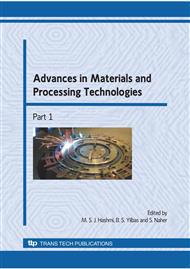p.616
p.622
p.630
p.637
p.646
p.654
p.661
p.672
p.680
Cutting Performance and Predictive Models for End Milling Aluminum Alloy
Abstract:
End milling is considered to be one of the most commonly applied for both roughing and finishing operations to make flat surfaces, slots and pockets in precision molds and dies. Predictive models were developed for cutting force, flank wear and surface roughness in end milling aluminum alloy by regression analysis. The correlation coefficients for cutting force, flank wear and surface roughness equations were 91.6 %, 89.8 % and 79.6 %, respectively. The goal of these predictive equations is to become a good assistant to the researcher in understanding the machining process. Through the analysis of variance (ANOVA), however, it can be found that the cutter diameter, the helix angle and the feed rate are the important milling process parameters to obtain the machined quality on cutting force, flank wear and surface roughness. The investigations show that cutting force, flank wear and surface roughness can be improved in end milling aluminum alloy by using the lower cutter diameter, medium helix angle and lower feed rate.
Info:
Periodical:
Pages:
646-653
Citation:
Online since:
December 2009
Authors:
Price:
Сopyright:
© 2010 Trans Tech Publications Ltd. All Rights Reserved
Share:
Citation:


